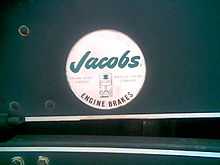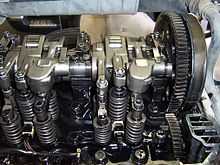Compression release engine brake



A compression release engine brake, frequently called a Jake brake or Jacobs brake, is an engine braking mechanism installed on some diesel engines. When activated, it opens exhaust valves in the cylinders after the compression cycle, releasing the compressed air trapped in the cylinders, and slowing the vehicle.
Although Jake brake properly refers to the Jacobs brand of engine brakes, the term has become a genericized trademark and is often used to refer to engine brakes or compression release engine brakes in general, especially on large vehicles or heavy equipment.
Function
When the driver releases the accelerator on a moving vehicle powered by a diesel engine, the vehicle's forward momentum continues to turn the engine's crankshaft. With the example of Mercedes diesels being a notable exception, diesel engines, by design, have no throttle butterfly in the intake so regardless of throttle setting a full charge of air is always drawn into the cylinder. As such, each time air is compressed in a cylinder virtually 100% of that energy is returned to the crankshaft providing very little in the way of engine braking to the vehicle.
The typical compression release engine brake, as originally developed, uses an add-on Hydraulic system utilizing engine oil. When activated the motion of the fuel injector rocker arm is transferred to the engine exhaust valve(s). This occurs very near TDC and releases the compressed air in the cylinder so that that energy is not returned to the crankshaft. Energy is now absorbed and engine becomes an excellent "brake." If used properly this energy can be used by the truck driver to maintain speed or even slow the vehicle with little or no use of the service brakes.
Contrast a gasoline engine, where the mechanics are different and a special valve is not necessary for engine braking to happen when the driver releases the accelerator. In a gasoline engine, when the accelerator released, the throttle prevents the free flow of air into the cylinders, so there is little pressure to release at the top of the compression stroke. The closed throttle provides engine braking by forcing the engine to generate a vacuum between the throttle and the cylinders.
Diesel compression release brake controls consist of an on/off switch and, often, a multi-position switch that controls the number of cylinders on which the brake is active. Throttle and clutch switches are integral with the system. Activation occurs when both the clutch is released with transmission in gear and the throttle is released. It is the driver's job to ascertain the correct transmission gear to use depending on, for example, the steepness of the grade and whether the truck is loaded or empty.
The name is derived from the manufacturer, Jacobs (of drill chuck fame), and was patented 1962–1965 by Clessie Cummins.[1]
Legislation
The use of compression release engine brakes may cause a vehicle to make a loud chattering or "machine gun" exhaust noise, especially vehicles having high flow mufflers, or no mufflers at all, causing many communities in the United States and Canada to prohibit compression braking within municipal limits. Drivers are notified by roadside signs with legends such as "Brake Retarders Prohibited," "Engine Braking Restricted," "Jake Brakes Prohibited," "No Jake Brakes," "Compression Braking Prohibited," "Limit Compression Braking," "Avoid Using Engine Brakes," or "Unmuffled Compression Braking Prohibited," and enforcement is typically through traffic fines. Such prohibitions have led to the development of new types of mufflers and turbochargers to better silence compression braking noise.
Jacobs claims that the use of the term "Jake Brakes" on signs prohibiting engine retarding brakes violates their trademark and discriminates against Jacobs brand products.[2][3]
See also
- Engine braking
- Compression release
- Exhaust brake
- Retarder (mechanical engineering)
- Jacobs Vehicle Systems
Notes
- ↑ US Patent # 3,220,392, filed June 4, 1962, issued Nov. 30, 1965; http://files.asme.org/ASMEORG/Communities/History/Landmarks/5577.pdf
- ↑ "Jacobs Vehicle Systems - Noise Concerns". jake-brakes.com. Retrieved August 20, 2012.
- ↑ Zolkos, Rodd (February 28, 2000). "Road signs violate trademark; Municipals urged to stop using 'Jake Brakes' brand name". Business Insurance. Crain Communications Inc. Retrieved August 20, 2012 – via HighBeam. (subscription required (help)).